Design of Dual Circularly Polarized Sequentially-Fed Patch Antennas for Satellite Applications
Abstract
:1. Introduction
2. Design and Characterization of a Dual-CP Sequentially-Fed Single Patch Antenna
3. Dual-CP 2-by-2 Array Antenna for Satcom Applications
4. Array Prototype Fabrication and Measurements
5. Conclusions
Author Contributions
Funding
Acknowledgments
Conflicts of Interest
References
- Di Carlo, C.; Di Donato, L.; Mauro, G.; La Rosa, R.; Livreri, P.; Sorbello, G. A circularly polarized wideband high gain patch antenna for wireless power transfer. Microw. Opt. Technol. Lett. 2018, 60, 620–625. [Google Scholar] [CrossRef]
- Pavone, S.C.; Casaletti, M.; Albani, M. Automatic Design of a CP Fan-Beam Linear Slotted Array in SIW Technology. IEEE Access 2019, 7, 155977–155985. [Google Scholar] [CrossRef]
- Liao, S.; Xue, Q. Compact UHF Three-Element Sequential Rotation Array Antenna for Satcom Applications. IEEE Trans. Antennas Propag. 2017, 65, 2328–2338. [Google Scholar] [CrossRef]
- Zaid, J.; Abdulhadi, A.; Kesavan, A.; Belaizi, Y.; Denidni, T.A. Multiport Circular Polarized RFID-Tag Antenna for UHF Sensor Applications. Sensors 2017, 17, 1576. [Google Scholar] [CrossRef] [PubMed] [Green Version]
- Yasin, T.; Baktur, R. Circularly polarized meshed patch antenna for small satellite application. IEEE Antennas Wirel. Propag. Lett. 2013, 12, 1057–1060. [Google Scholar] [CrossRef]
- Nascetti, A.; Pittella, E.; Teofilatto, P.; Pisa, S. High-Gain S-band Patch Antenna System for Earth-Observation CubeSat Satellites. IEEE Antennas Wirel. Propag. Lett. 2015, 14, 434–437. [Google Scholar] [CrossRef]
- Falade, O.P.; Rehman, M.U.; Gao, Y.; Chen, X.; Parini, C.G. Single feed stacked patch circular polarized antenna for triple band GPS receivers. IEEE Trans. Antennas Propag. 2012, 60, 4479–4484. [Google Scholar] [CrossRef]
- Squadrito, P.; Livreri, P.; Di Donato, L.; Squadrito, C.; Sorbello, G. A Telemetry, Tracking, and Command Antennas System for Small-Satellite Applications. Electronics 2019, 8, 689. [Google Scholar] [CrossRef] [Green Version]
- Pavone, S.C.; Ettorre, M.; Casaletti, M.; Albani, M. Transverse circular-polarized Bessel beam generation by inward cylindrical aperture distribution. Opt. Expr. 2016, 24, 11103–11111. [Google Scholar] [CrossRef]
- Pavone, S.C.; Mazzinghi, A.; Freni, A.; Albani, M. Comparison between broadband Bessel beam launchers based on either Bessel or Hankel aperture distribution for millimeter wave short pulse generation. Opt. Express 2017, 25, 19548–19560. [Google Scholar] [CrossRef]
- Comite, D.; Fuscaldo, W.; Pavone, S.C.; Valerio, G.; Ettorre, M.; Albani, M.; Galli, A. Propagation of nondiffracting pulses carrying orbital angular momentum at microwave frequencies. Appl. Phys. Lett. 2017, 110, 114102. [Google Scholar] [CrossRef] [Green Version]
- Wissan, V.; Firmansyah, I.; Rizki Akbar, P.; Sri Sumantyo, J.T.; Kuze, H.; Yohandri, V. Development of circularly polarized array antenna for synthetic aperture radar sensor installed on UAV. Prog. Electromagn. Res. 2011, 19, 119–133. [Google Scholar]
- Pavone, S.C.; Martini, E.; Albani, M.; Maci, S.; Renard, C.; Chazelas, J. A novel approach to low profile scanning antenna design using reconfigurable Metasurfaces. In Proceedings of the 2014 International Radar Conference, Lille, France, 13–17 October 2014; pp. 1–4. [Google Scholar] [CrossRef]
- Teshirogi, T.; Tanaka, M.; Chujo, W. Wideband circularly polarised array antenna with sequential rotations and phase shifts of elements. In Proceedings of the Intern. Symp. Antennas Propag (ISAP 85), Kyoto, Japan, 7–9 October 1985. [Google Scholar]
- Hall, P.S.; Dahele, J.S.; James, J.R. Design principles of sequentially fed, wide bandwidth, circularly polarised microstrip antennas. IEE Proc. 1989, 136, 381–389. [Google Scholar] [CrossRef]
- Deng, C.; Li, Y.; Zhang, Z.; Feng, Z. A Wideband Sequential-Phase Fed Circularly Polarized Patch Array. IEEE Trans. Antennas Propag. 2014, 62, 3890–3893. [Google Scholar] [CrossRef]
- Garg, R.; Bhartia, P.; Bahl, I.J.; Ittipiboon, A. Microstrip Antenna Design Handbook; Artech House: Massachusetts, MA, USA, 2001. [Google Scholar]
- Chen, X.; Fu, G.; Gong, S.; Yan, Y.; Zhao, W. Circularly Polarized Stacked Annular-Ring Microstrip Antenna With Integrated Feeding Network for UHF RFID Readers. IEEE Antennas Wirel. Propag. Lett. 2010, 9, 542–545. [Google Scholar] [CrossRef]
- Wincza, K.; Gruszczynski, S. Microstrip Antenna Arrays Fed by a Series-Parallel Slot-Coupled Feeding Network. IEEE Antennas Wirel. Propag. Lett. 2011, 10, 991–994. [Google Scholar] [CrossRef]
- Harine, G.; Pavone, S.C.; Di Donato, L.; Di Mariano, P.; Distefano, G.; Livreri, P.; Prabagarane, N.; Squadrito, C.; Sorbello, G. Design of a Compact Dual Circular-Polarized Antenna for L-Band Satellite Applications. IEEE Antennas Wirel. Propag. Lett. 2020. [Google Scholar] [CrossRef]
- Mauro, G.S.; Torrisi, G.; Di Mariano, P.; Squadrito, C.; Emanuele, S.; Di Donato, L.; Sorbello, G. Wide Bandwidth Dual Port, Dual Sense Circular Polarization Antenna for Satellite Applications. In Proceedings of the ICEAA 2019, Granada, Spain, 9–13 September 2019. [Google Scholar]
- Balanis, C.A. Advanced Engineering Electromagnetics; John Wiley & Sons: New York, NY, USA, 2012. [Google Scholar]
- Wong, Y.S.; Zheng, S.Y.; Chan, W.S. Quasi-Arbitrary Phase-Difference Hybrid Coupler. IEEE Trans. Microw. Theory Tech. 2012, 60, 1530–1539. [Google Scholar] [CrossRef]
- Wu, Y.; Jiao, L.; Xue, Q.; Liu, Y. A Universal Approach for Designing an Unequal Branch-Line Coupler With Arbitrary Phase Differences and Input/Output Impedances. IEEE Trans. Compon. Packag. Manuf. Technol. 2017, 7, 944–955. [Google Scholar] [CrossRef]
- Park, M. Comments on “Quasi-arbitrary phase-difference hybrid coupler”. IEEE Trans. Microw. Theory Tech. 2013, 61, 1397–1398. [Google Scholar] [CrossRef]
- Wu, Y.; Shen, J.; Liu, Y. Comments on “Quasi-Arbitrary Phase-Difference Hybrid Coupler”. IEEE Trans. Microw. Theory Tech. 2013, 61, 1725–1727. [Google Scholar] [CrossRef]
- Ahn, H.; Tentzeris, M.M. Comments on “A Universal Approach for Designing an Unequal Branch-Line Coupler With Arbitrary Phase Differences and Input/Output Impedances”. IEEE Trans. Compon. Packag. Manuf. Technol. 2019, 9, 1208–1209. [Google Scholar] [CrossRef]
- Wu, Y.; Jiao, L.; Xue, Q.; Liu, Y. Reply to “Comments on ‘A Universal Approach for Designing an Unequal Branch-Line Coupler with Arbitrary Phase Differences and Input/Output Impedances’”. IEEE Trans. Compon. Packag. Manuf. Technol. 2019, 9, 1210–1216. [Google Scholar] [CrossRef]
- Tran, H.H.; Park, I. Wideband circularly polarized cavity-backed asymmetric crossed bowtie dipole antenna. IEEE Antennas Wirel. Propag. Lett. 2015, 15, 358–361. [Google Scholar] [CrossRef]
- Pavone, S.C.; Albani, M. Exact Formulas for the Determination of Antenna Local Phase Center. In Proceedings of the 2019 13th European Conference on Antennas and Propagation (EuCAP), Kraków, Poland, 31 March–4 April 2019; pp. 1–3. [Google Scholar]
- Gharibi, H.; Hojjat-Kashani, F. Design of a wideband monopulse antenna using four conical helix antennas. Prog. Electromagn. Res. 2012, 29, 25–33. [Google Scholar] [CrossRef] [Green Version]
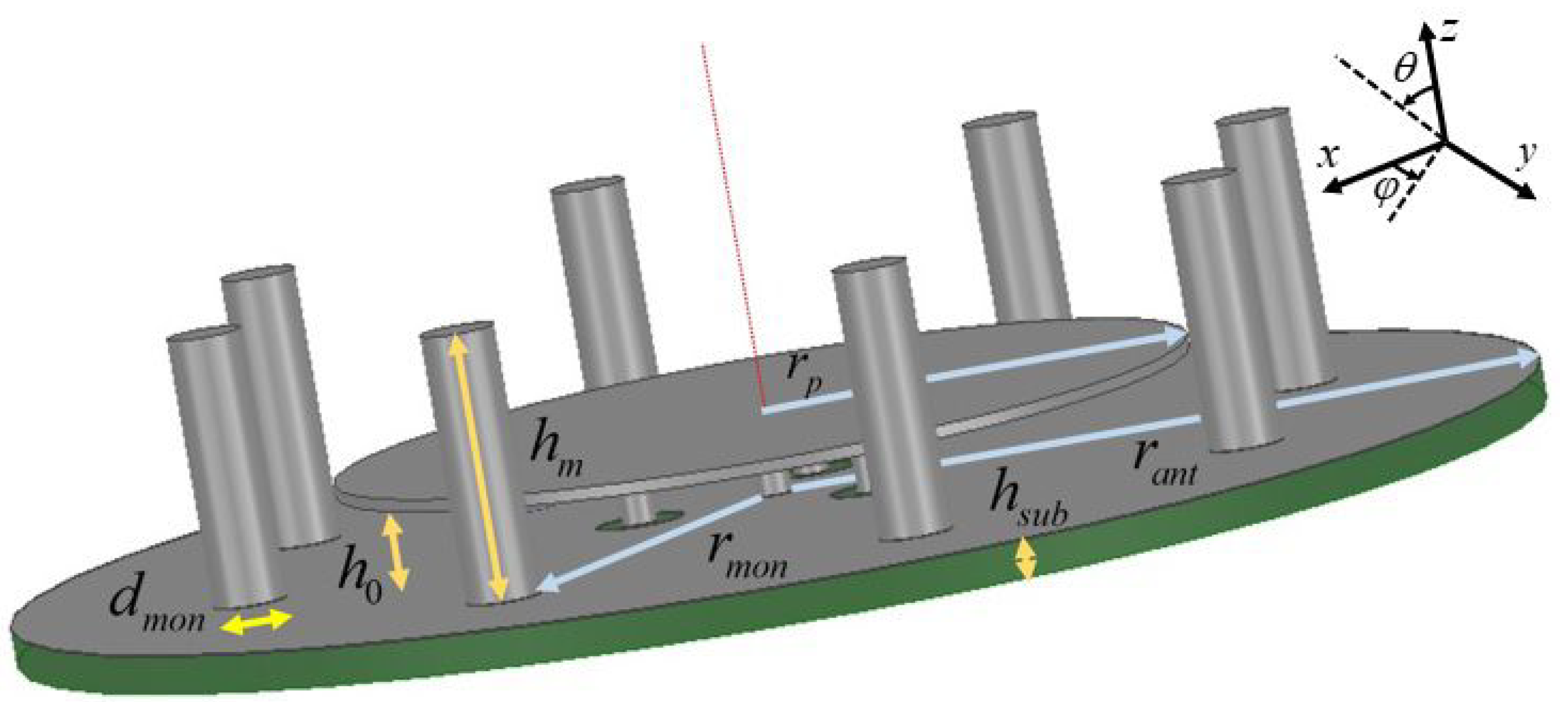


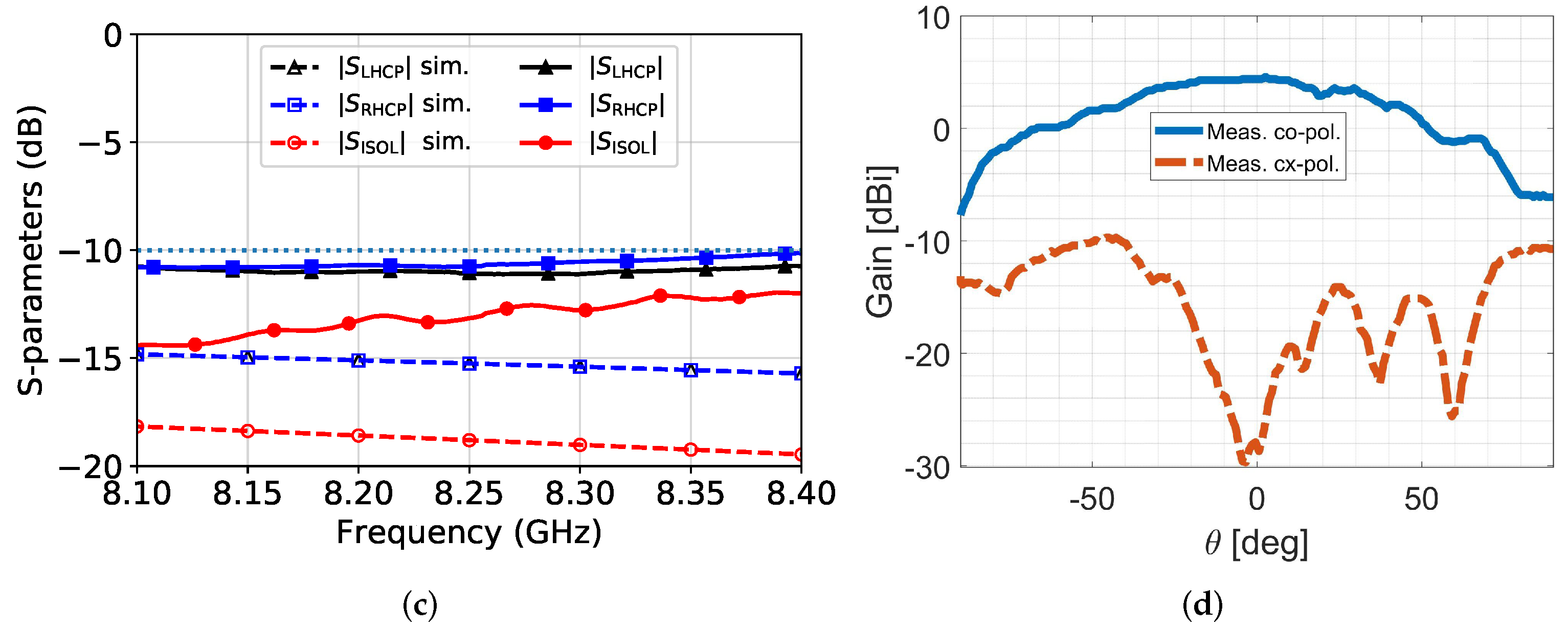

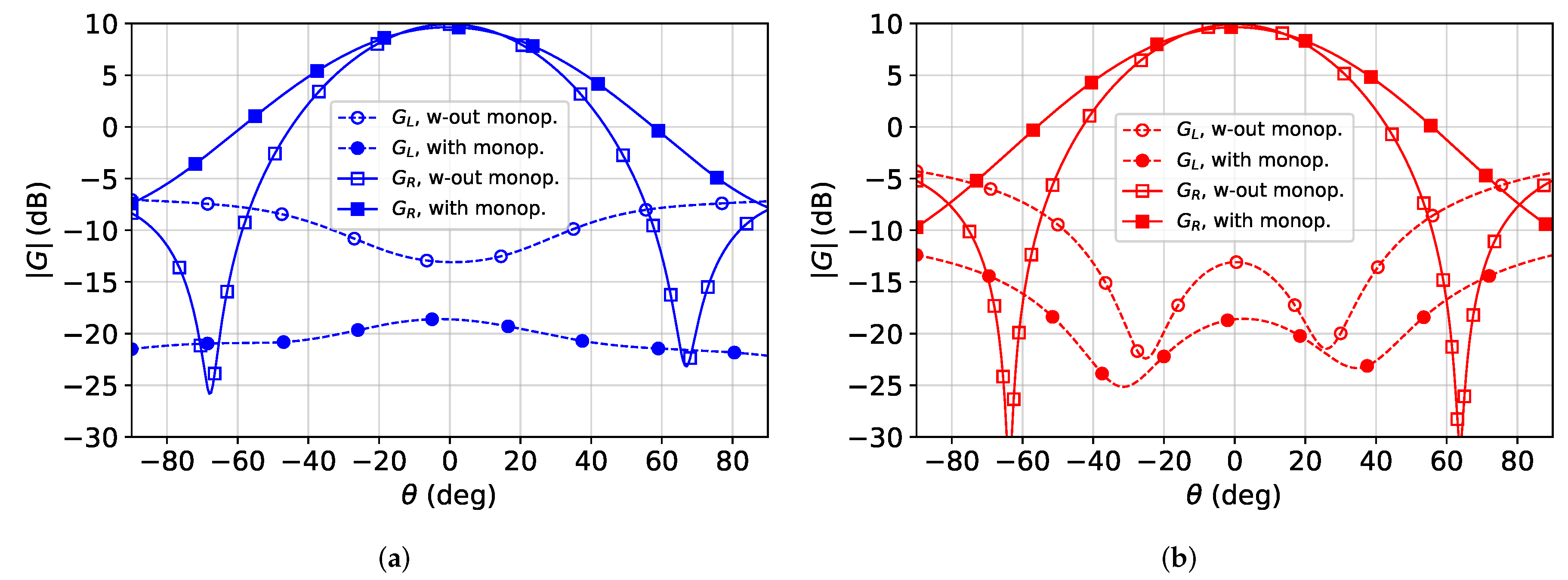

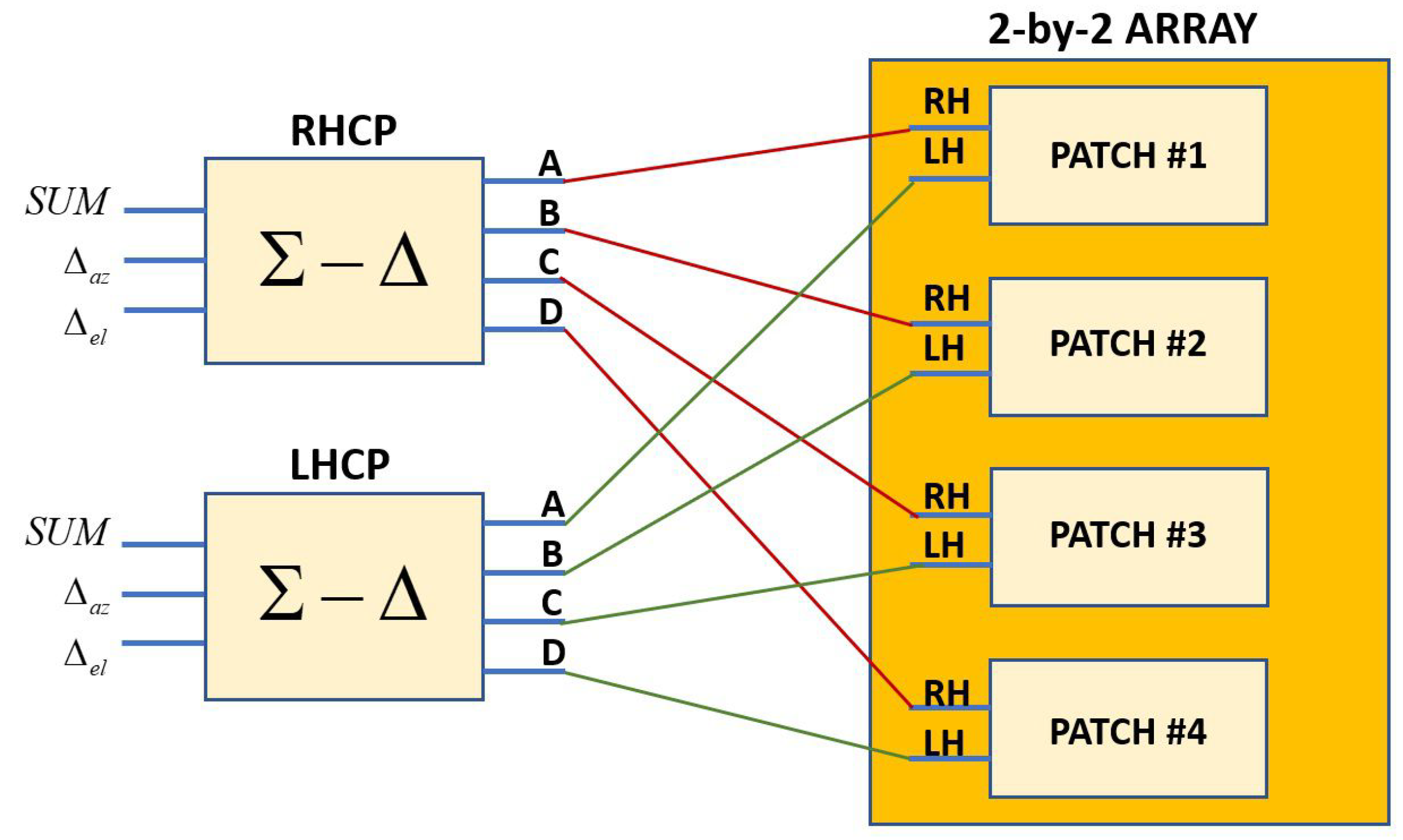
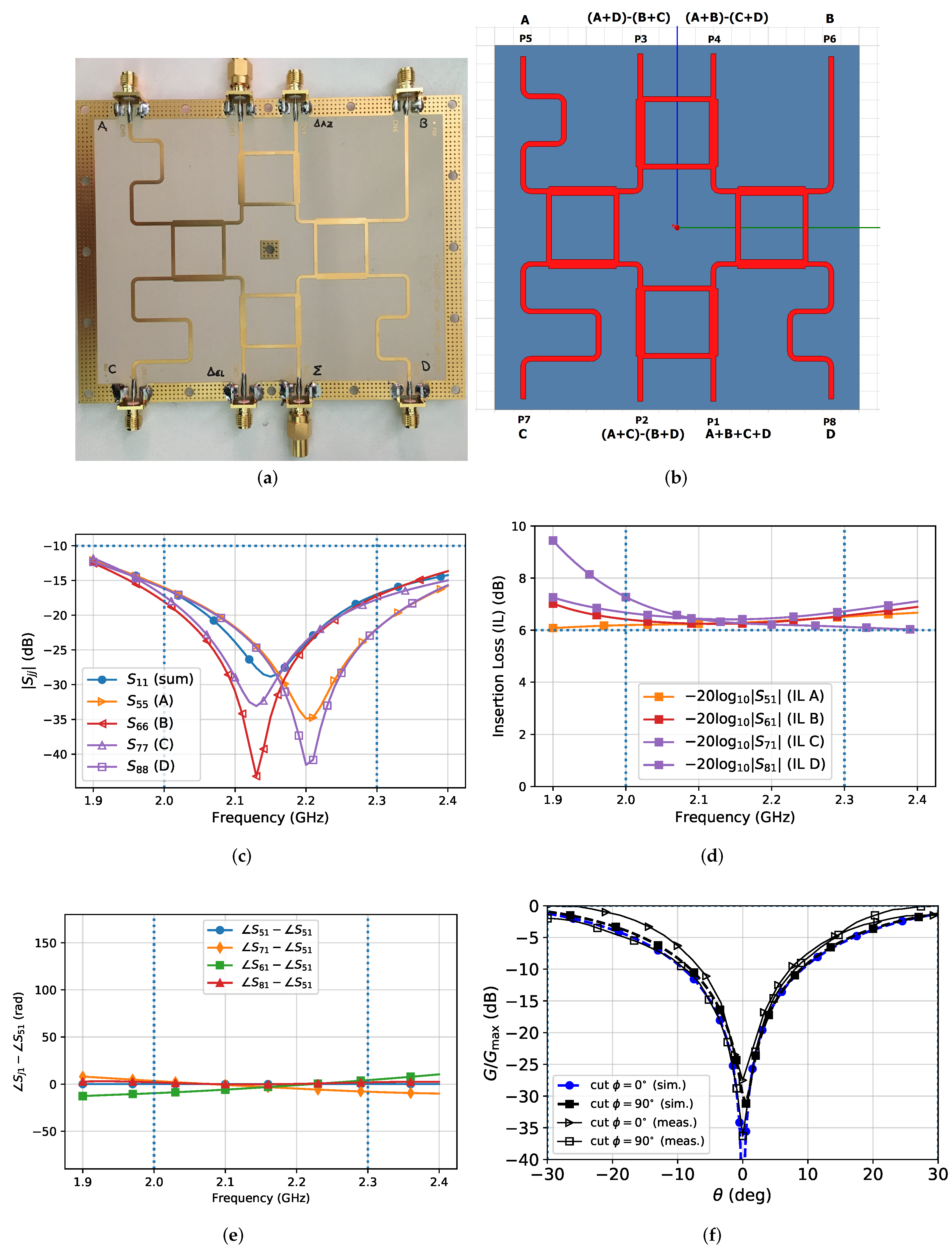
| Microstrip Line | Impedance [] | Length [mm] |
|---|---|---|
| Parameter | Description | Value [mm] | Value [] |
|---|---|---|---|
| Antenna radius | |||
| Patch radius | |||
| Monopole position | 11 | ||
| Monopole diameter | |||
| Substrate thickness | |||
| Monopole heights | |||
| Patch height |
| Parameter | Description | Value [mm] | Value [] |
|---|---|---|---|
| Dielectric thickness | |||
| Air gap thickness | 9 | ||
| Patch radius | 29 | ||
| Monopole radius | 1 | ||
| Monopole heights | 24 | ||
| Patch cut length | 41 | ||
| Adjacent monopole distance | 4 |
© 2020 by the authors. Licensee MDPI, Basel, Switzerland. This article is an open access article distributed under the terms and conditions of the Creative Commons Attribution (CC BY) license (http://creativecommons.org/licenses/by/4.0/).
Share and Cite
Pavone, S.C.; Mauro, G.S.; Donato, L.D.; Sorbello, G. Design of Dual Circularly Polarized Sequentially-Fed Patch Antennas for Satellite Applications. Appl. Sci. 2020, 10, 2107. https://doi.org/10.3390/app10062107
Pavone SC, Mauro GS, Donato LD, Sorbello G. Design of Dual Circularly Polarized Sequentially-Fed Patch Antennas for Satellite Applications. Applied Sciences. 2020; 10(6):2107. https://doi.org/10.3390/app10062107
Chicago/Turabian StylePavone, Santi Concetto, Giorgio Sebastiano Mauro, Loreto Di Donato, and Gino Sorbello. 2020. "Design of Dual Circularly Polarized Sequentially-Fed Patch Antennas for Satellite Applications" Applied Sciences 10, no. 6: 2107. https://doi.org/10.3390/app10062107







